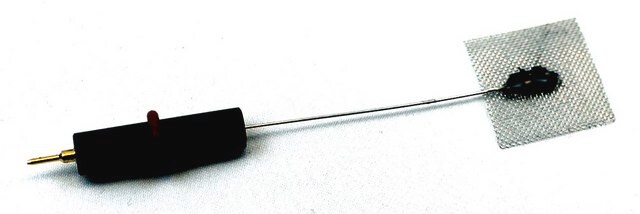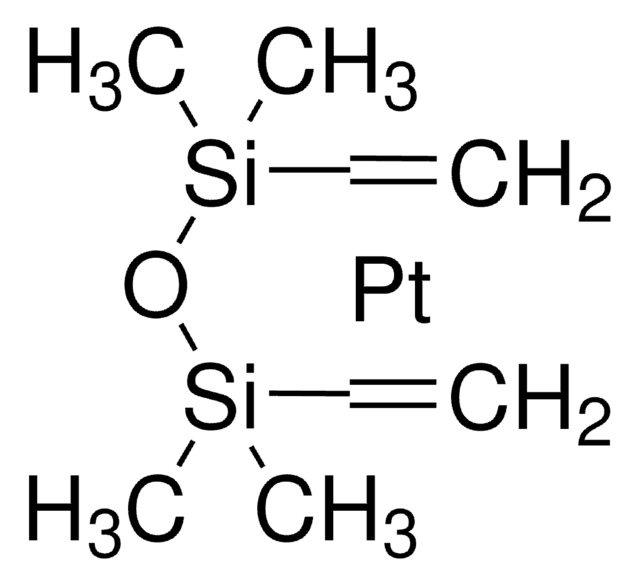267228
Platinum
wire, diam. 0.5 mm, 99.9% trace metals basis
Synonym(s):
Platinum element, Platinum gray
Sign Into View Organizational & Contract Pricing
All Photos(1)
About This Item
Empirical Formula (Hill Notation):
Pt
CAS Number:
Molecular Weight:
195.08
EC Number:
MDL number:
UNSPSC Code:
12141734
PubChem Substance ID:
NACRES:
NA.23
Recommended Products
Quality Level
assay
99.9% trace metals basis
form
wire
resistivity
10.6 μΩ-cm, 20°C
diam.
0.5 mm
bp
3827 °C (lit.)
mp
1772 °C (lit.)
density
21.45 g/cm3 (lit.)
SMILES string
[Pt]
InChI
1S/Pt
InChI key
BASFCYQUMIYNBI-UHFFFAOYSA-N
General description
Platinum (Pt) is a highly ductile, malleable and unreactive metal. It is resistant to corrosion and stable at high temperatures. Although resistant to hydrochloric and nitric acid, it dissolves readily in hot aqua regia to form chloroplatinic acid.
Application
Platinum wire finds major applications as an electrode, such as:
- Auxiliary electrode in flow cell to determine ammonia content.
- Electrodes for photoconductive stimulation of neurons cultured on silicon wafers.
- Electrode to give current flow in electrophoresis chamber for ion migration.
- As a microelectrode-indicator electrode in voltammetry.
- As a transvascular embolic agent.
- To study chronopotentiometry of hydrogen peroxide with a platinum wire electrode or
- In gas detection instruments.
Quantity
1 g = 25 cm; 4 g = 100 cm
Storage Class
13 - Non Combustible Solids
wgk_germany
nwg
flash_point_f
Not applicable
flash_point_c
Not applicable
Choose from one of the most recent versions:
Already Own This Product?
Find documentation for the products that you have recently purchased in the Document Library.
Customers Also Viewed
Karl Crowley et al.
The Analyst, 133(3), 391-399 (2008-02-27)
A sensor for the amperometric detection of aqueous ammonia was fabricated using the inkjet printing of dodecylbenzene sulfonate (DBSA)-doped polyaniline nanoparticles (nanoPANI) onto a screen-printed carbon paste electrode. The combination of the environmentally inert, aqueous nanoparticle dispersion with the inkjet
Voltammetry with Stationary Microelectrodes of Platinum Wire.
Laitinen HA and Kolthoff IM
The Journal of Physical Chemistry, 45(7), 1061-1079 (1941)
Shai Rozen et al.
Plastic and reconstructive surgery, 131(6), 1253-1265 (2013-05-30)
Left untreated, paralytic lagophthalmos may result in corneal dryness, ulcerations, and subsequent blindness. The most common nondynamic surgical solution is upper eyelid weight placement in a superficial, pretarsal pocket, carrying the risk of visibility, extrusion, and entropion. The authors present
Wei Sun et al.
Materials science & engineering. C, Materials for biological applications, 33(4), 1907-1913 (2013-03-19)
In this paper a platinum (Pt) nanoparticle decorated graphene (GR) nanosheet was synthesized and used for the investigation on direct electrochemistry of myoglobin (Mb). By integrating GR-Pt nanocomposite with Mb on the surface of carbon ionic liquid electrode (CILE), a
Loris De Cecco et al.
PloS one, 8(3), e58849-e58849 (2013-03-14)
We recently reported that peritumoral CpG-ODN treatment, activating TLR-9 expressing cells in tumor microenvironment, induces modulation of genes involved in DNA repair and sensitizes cancer cells to DNA-damaging cisplatin treatment. Here, we investigated whether this treatment induces modulation of miRNAs
Our team of scientists has experience in all areas of research including Life Science, Material Science, Chemical Synthesis, Chromatography, Analytical and many others.
Contact Technical Service





